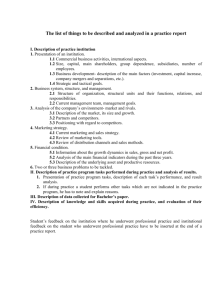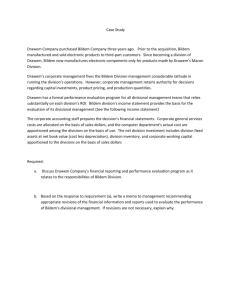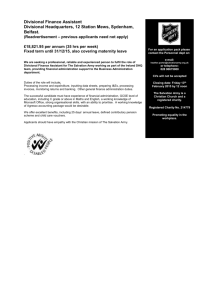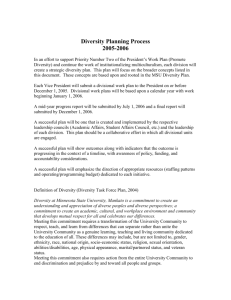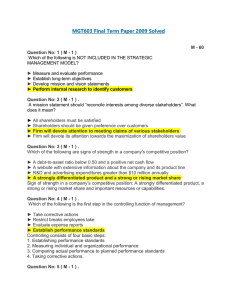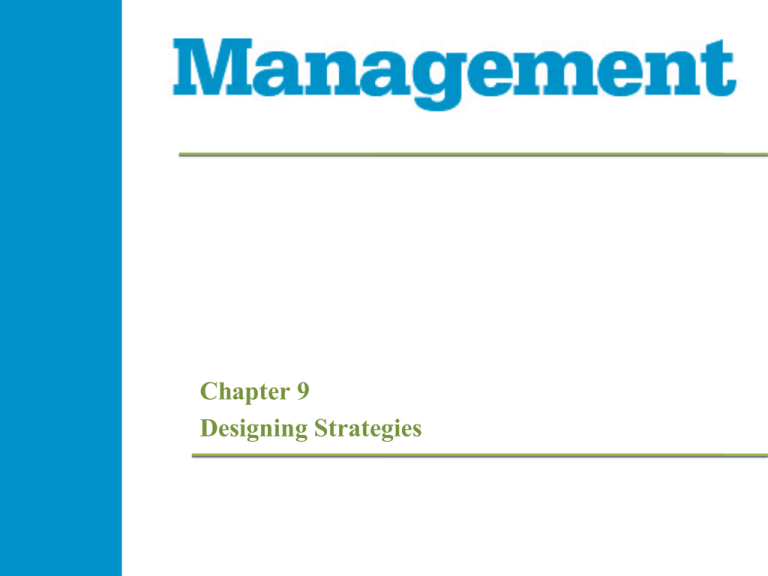
Chapter 9
Designing Strategies
Learning Objectives
Explain how businesses use planning to solve
problems and make a difference
Distinguish how planning is different at the
organizational, divisional, and functional levels
of a business
Explain how senior managers develop
organizational strategies and business plans
Outline methods that managers use to understand
their industries and competitors
Management 1e
9- 2
Learning Objectives (cont.)
Describe how managers assess the organization’s
capacity to execute proposed business plans
Demonstrate how managers develop divisional
strategies and tactical plans
Compare traditional strategic planning models to
an event-based approach
Management 1e
9- 3
How Managers Plan to Make a
Difference (p. 228)
Designing and developing strategies is a
continuous process that helps organizations
determine what they do, why they should be in
business, how they can win and sustain market
share, and how they can continually innovate to
keep ahead of the competition
Acquisition (p. 230)
• When an organization purchases another
organization or business in order to grow
Management 1e
9- 4
Different Levels of Strategy (p. 230)
Strategy
• Plan of action for achieving goals
• Three levels of strategy
Organizational strategy – corporate level strategy that
addresses the question “What business are we in?” and
unites all parts of the organization
Divisional strategy – strategy that determines how a
business will compete in a particular industry or market
Functional strategy – strategy that determines how
employees will implement and achieve a tactical plan
Management 1e
9- 5
Different Levels of Strategy (cont.)
Organizational, divisional, and functional
strategies are documented using business,
tactical, and operational plans, respectively
• Business plan – stated actions and goals that support
the organizational strategy (p. 230)
• Tactical plan – stated actions and goals that support
achieving the divisional strategy
• Operational plan – stated actions and goals that
support achieving the functional strategy
Management 1e
9- 6
Different Levels of Strategy (cont.)
Connecting “mission, vision,
and values” to strategies
and plans
Figure 9.1
Management 1e
9- 7
Organizational Strategies (p. 231)
Organizational strategies designed to gain a competitive
advantage
• Characteristics of an organization’s products or services that
distinguish it from competitors and provide an advantage in
the market
Reactor
• Company that does not follow a consistent strategy but just
responds to changes in the environment
Analyzer
• Company whose strategies seek to maintain existing products
and services while pursuing limited innovation
Often imitate or follow the proven success of prospector organizations
Management 1e
9- 8
Organizational Strategies (cont.)
Defender (p. 231)
• Company whose strategies support stable growth
and continual improvement of existing products
and services
• Stability strategy – organization focuses on
processes, products, and services that will sustain
it over the long term (p. 232)
• Cost leadership strategy – organization seeks
competitive advantage by reducing production
costs and therefore consumer prices
Management 1e
9- 9
Organizational Strategies (cont.)
Prospector (p. 232)
• Company that uses strategies for high-risk, fast
growth through product and market innovation
• First mover – company that gains competitive
advantage by being the first to offer a new product
or service, or to use a new cost-saving technology
Management 1e
9- 10
Industry and Competitive Analysis
(p. 232)
Competitive analysis
• Process of assessing and monitoring the competition
in order to design more effective strategies
Five forces model (p. 233)
• Michael Porter
• Allows managers to assess the major threats that an
organization can expect to encounter
• Enables continued reinvention and shaping of the
business to reflect market changes
Management 1e
9- 11
Industry and Competitive Analysis
(cont.)
Five forces model
Figure 8.2
Management 1e
9- 12
Industry and Competitive Analysis
(cont.)
Five forces model (cont.)
• Power of suppliers – ability to increase prices
• Power of buyers (customers) – ability to decrease
prices charged by company for its products or
services (p. 234)
• Substitute products and services – importance of
uniqueness of company’s products or services
• Rivalry – increase in competitors that offer the same
products or services (p. 236)
Management 1e
9- 13
Industry and Competitive Analysis
(cont.)
Five forces model (cont.)
• New entrants – new competitors that enter the market
(p. 234)
Barriers to entry – obstacle that makes it difficult for an
organization to enter a particular market or replicate a
competitor’s service or product offerings
Management 1e
Supply-side economies of scale (p. 235)
Demand-side benefits of scale
Customer switching costs
Capital requirements
Incumbent advantages independent of size
Unequal access to distribution channels (p. 236)
Restrictive government policy
9- 14
Industry and Competitive Analysis
(cont.)
Five forces model (cont.)
• New entrants (cont.)
Expected retaliation (p. 236)
Financial resources of incumbent, loyalty of customer base,
and control over distribution channels
Incumbent’s ability to reduce prices
Industry growth rate
Management 1e
9- 15
Organizational Position and Capacity
(p. 237)
Resources
• Assets, people, processes, and capabilities of an
organization
Market position
• Honest assessment about how the company
competes in its industry
Capacity
• Financial and human resources available to the
company which will enable or hinder it to achieve
its goals
Management 1e
9- 16
Organizational Position and Capacity
(p. 237)
Company position
• Boston Consulting Group Matrix – framework for
evaluating business units according to growth and
market share (p. 237)
Largely based on the proportion of the market
controlled by the organization
Growth strategy – strategy for increasing revenue,
profits, market share, or territories (p. 238)
High growth markets – total business is expanding
Management 1e
9- 17
Organizational Position and Capacity
(cont.)
BCG Matrix
Figure 8.3
Management 1e
9- 18
Organizational Position and Capacity
(cont.)
BCG Matrix (cont.)
• Business’s position in the matrix determines a strategic
recommendation (p. 238)
• Dogs (low market share/low market growth)
• Cash cows (high market share/low market growth)
• Stars (high market share/high market growth; p. 239)
• Question marks (low market share/high market growth
SWOT analysis
• Method of assessing an organization’s strengths, weaknesses,
opportunities, and threats
Management 1e
9- 19
Organizational Position and Capacity
(cont.)
Capabilities and resources (p. 240)
• Core capabilities (competencies) – activities and
processes that an organization routinely does well
in comparison to its competitors
• Resources – assets, people, and processes of an
organization
Management 1e
9- 20
Organizational Position and Capacity
(cont.)
Growth and underinvestment archetype
Figure 9.4
Management 1e
9- 21
Strategies for Performance (p. 245)
Focus strategy (p. 246)
• Organization concentrates on a specific target
market
• May employ cost leadership and/or differentiation
strategies
Differentiation strategy
• Organization seeks competitive advantage by
providing goods or services that are significantly
different from the competition
Management 1e
9- 22
Strategies for Performance (cont.)
Vertical integration (p. 247)
• Diversification method in which an organization
adopts:
Backward integration - begins producing its own
supplies
Form of diversification strategy in which an organization adds
new kinds of goods, services, or business units
Forward integration – takes on the distribution and
selling of its products
Renewal strategy
• Addresses declining performance through
retrenchment and regrowth
Management 1e
9- 23
Copyright
Copyright © 2014 John Wiley & Sons, Inc.
All rights reserved. Reproduction or translation of this work
beyond that permitted in Section 117 of the 1976 United States
Copyright Act without express permission of the copyright owner
is unlawful. Request for further information should be addressed
to the Permissions Department, John Wiley & Sons, Inc. The
purchaser may make back-up copies for his/her own use only and
not for distribution or resale. The Publisher assumes no
responsibility for errors, omissions, or damages, caused by the
use of these programs or from the use of the information herein.
Management 1e
9-- 24

